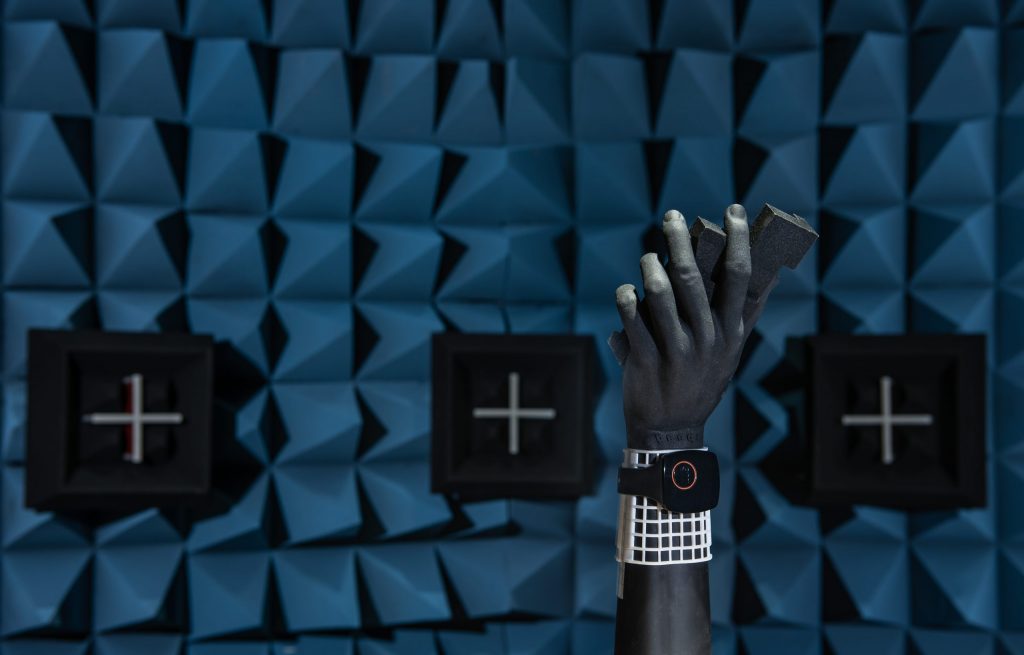What is Over-the-Air, OTA testing?
Over-the-Air, OTA testing, is a method to test the wireless performance and reliability of wireless devices that include embedded antennas. We are using these kinds of devices every day, such as mobile phones, IoT (Internet of Things) devices and different wearables, such as smartwatches. The performance of the antennas must be examined to ensure the wireless connectivity. It can be examined through OTA testing.
To perform an OTA test, the device under test (DUT) is placed in a test environment inside a test chamber. The test chamber is isolated from any outside signals. The goal of the OTA testing process is to ensure that the device has a good wireless performance at every situation. Many factors can affect the performance of a wireless device, for example choice of materials, placing of components and purpose of use. Typically, devices also need to be tested in different situations depending on their purpose of use. For example, a smartwatch must be tested in both hands, left and right, to ensure its wireless performance, but we will get to this in detail later.
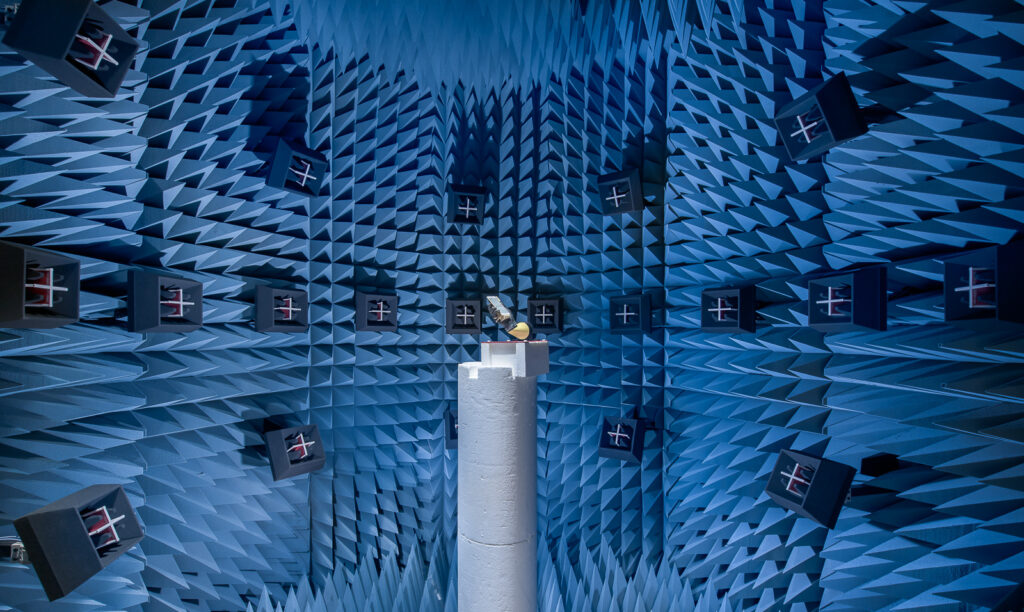
Why it is so important to do OTA testing?
We think you already know the answer to this question: no one likes bad connections, and bad connections could be avoided by verifying the wireless performance with OTA testing. An excellent wireless connectivity is an important criterion for consumers when making a purchase decision. Well-functioning wireless device builds trust in the brand and ensures that customers get the value they are expecting for. There are also many more reasons for performing an OTA test.
When OTA testing is done in an early phase, costly design errors can be avoided. If a product is launched and the manufacturer notices that the wireless performance of the device is not good, it can seriously harm the reputation of a company, not to mention the recall costs. Great OTA test result can also help with bench-marking. In addition, most of the biggest network operators have specific OTA requirements and to meet them, the product must be OTA tested. Overall, OTA testing ensures that the wireless device is ready to be sold on the market.
If you are interested about OTA testing in more detail, read our article Wireless Performance and OTA testing – Why testing your wireless device is important?
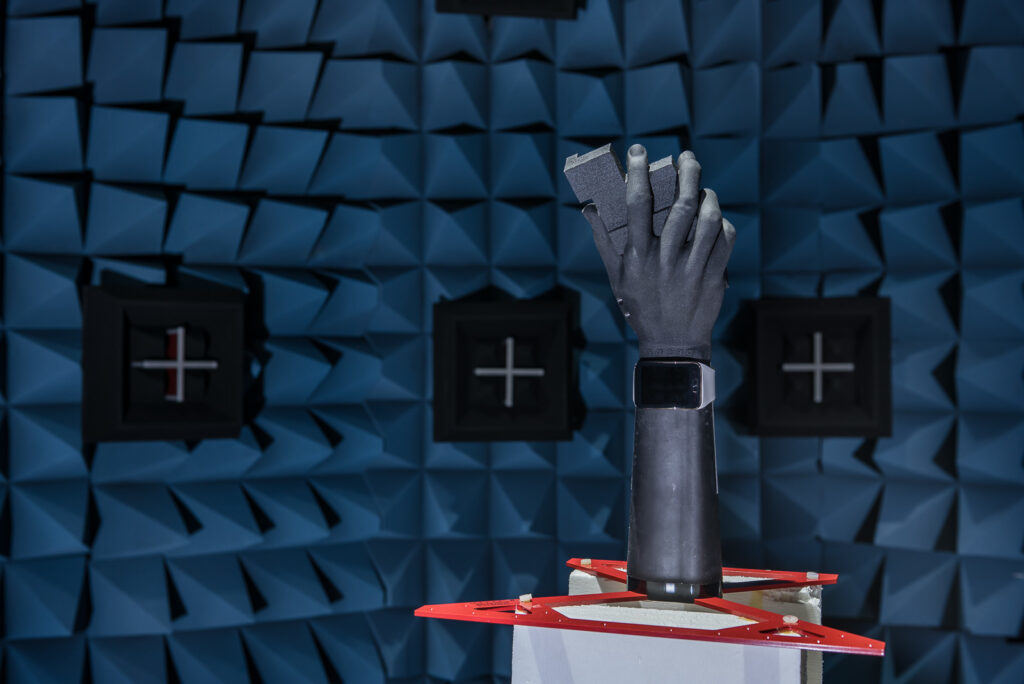
Over-the-Air, OTA testing process of a smartwatch
OTA testing typically measures the sensitivity and radiated transmission power of a device. Poor sensitivity and radiated transmission power affect a lot to end-user experience. First of all, if these measures are not satisfactory, the wireless connections to different radio systems may break up continuously or in the worst case, not connect at all. For example, the connection between a smartwatch and Bluetooth headset may break up or interrupt other radio connections.
In addition, these measures are important considering the battery consumption of the device. If the antennas and radio are not good enough, they must transmit the signal with more power and more frequently. This consumes the battery more quickly and affects a lot to an end-user’s experience. With smaller devices this is more noticeable since the battery is already small, and inefficient radio will use the battery even more quickly.
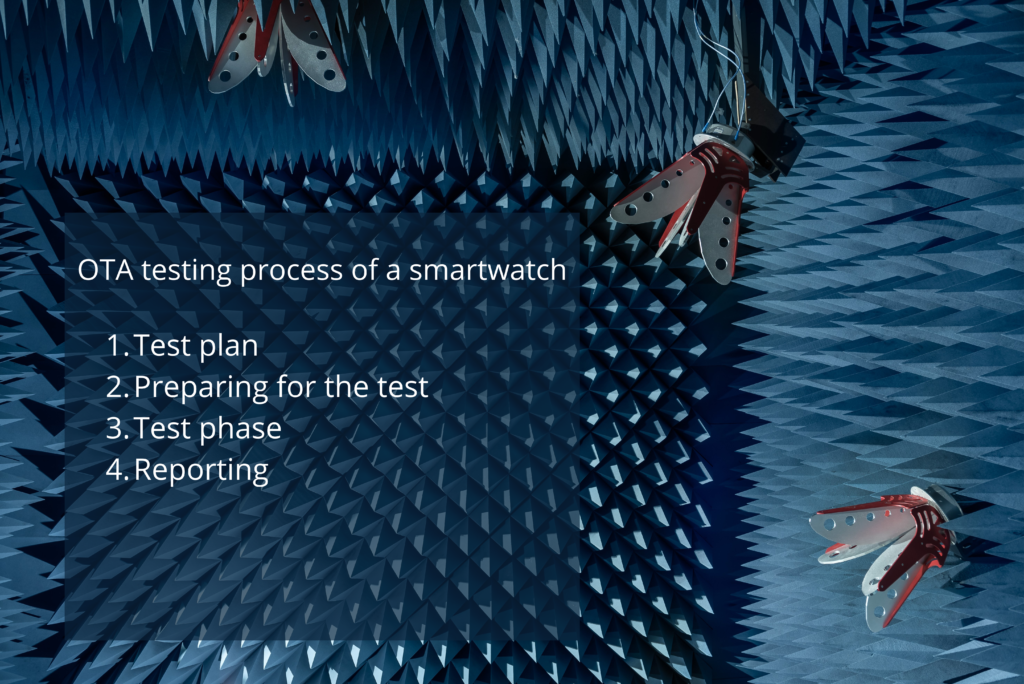
Over-the-Air, OTA testing can be done at any point of product development cycle. Our OTA testing process consists of four different phases:
- Preparing the test plan
- Preparing the device and the chamber for the test
- Actual OTA testing
- Reporting the results
Next, we will go through step by step how a smartwatch is OTA tested at Verkotan.
1. Test plan
Our OTA testing process begins with the test plan. In a test plan phase, it is important to define certain things, such as:
- What systems need to be measured
- What bands need to be measured
- What kinds of situations the device under test (DUT) is planned to be used
- Does the testing require an additional control software
What systems need to be measured
First, it is essential to know what systems need to be measured with OTA testing. Smartwatches usually utilize 2G, 3G, 4G and LTE-M networks. 5G is not utilized in smartwatches at the time, since 5G standalone is not yet commonly used. The connectivity of the watch to these networks needs to be tested to ensure the wireless performance.
Smartwatches also utilize Bluetooth, for example when connecting wireless headphones to the watch, WLAN (Wireless Local Area Network) and GNSS (Global Navigation Satellite System) that enables the use of the smartwatch without a close connection to a smartphone

What bands need to be measured
One thing to specify is what bands need to be measured. Different network operators work at different bands. Smartwatches typically use approximately 5 bands that the device manufacturer have chosen to be used in the device. Compared to mobile phones, the amount is fairly small: mobile phones may have even 30 bands that require testing. The transmission power of the device needs to be tested in all the bands that the DUT uses. In every band, the low, mid, and high frequency must be measured.
Compared to the transmission power, which is measured at low, mid, and high frequencies of a certain band, the sensitivity is measured at all the frequencies of a certain band. The sensitivity is measured in every frequency of all the bands used in the device to ensure that there are no disruptions in the band. This is extremely important in situations when there is more than one radio used at the same time, such as smartwatch and Bluetooth headset.
What is the purpose of use of the device
Another important thing to consider before the testing is the purpose of use of the device. With the watch it is easy to define, it will be used on a left or right wrist. Even though there is not much of a difference between the wrists, the watch must be tested in the positions of both wrists. The test must be performed in both wrists because the watch is in different positions on different wrists. This means that the embedded antennas are in different positions too depending on the hand, which may affect the performance.
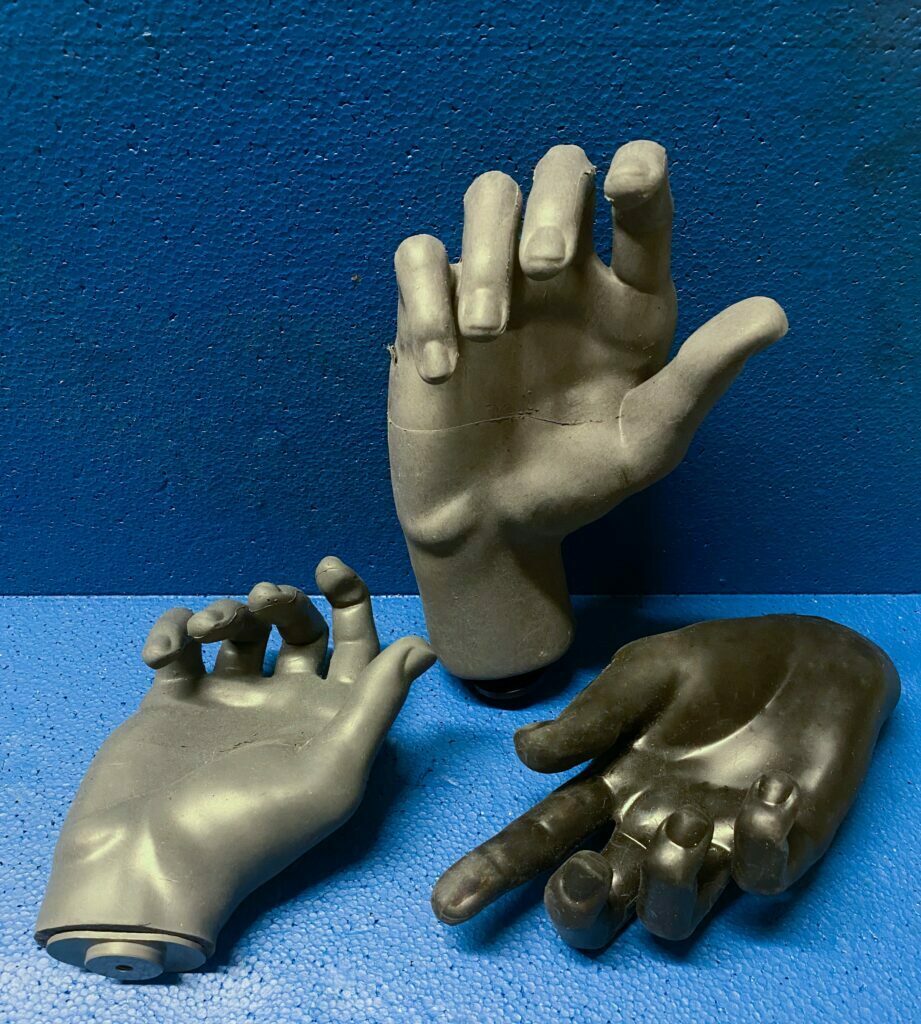
At Verkotan, we are using test phantom hands to measure the performance of a smartwatch, because the phantom hand has the same electrical conductivity as a human hand. Used phantom hands are standardized in size and in electrical properties. The measures of the phantom hands are defined to correspond to real human hands as precisely as possible. Therefore, the test result will be the same as with a real human hand.
The test can also be performed with an actual human hand, it just requires that somebody sits in a chamber with the watch on. This is not typically done with watches but is more often done with, for example, mobile phones, because the placement of the fingers and head can affect greatly the way the phone works. Sometimes the test is performed also without any hand, in a free space, to see how the watch functionates overall.
Is additional control software needed
Before the testing it is good to know if the testing requires an additional control software. Sometimes a control software is needed to control some specific systems. What comes to the OTA testing of a smartwatch, a control software is needed to be able to measure the wireless connection to WLAN. WLAN typically turns itself to a low-power mode, which must be taken off before performing the OTA test. With the control software the WLAN connection can be forced to stay on. With a smartwatch, a control software is also needed to measure the sensitivity of a Bluetooth connection.
2. Preparing for the Over-the-Air, OTA testing
Next step of our OTA testing process is to make sure that everything is ready for the actual OTA test. This step contains:
- Basic checks to the DUT
- Preparing the chamber
- Reference testing must be performed
- Attachment of the DUT into a test chamber.
Basic checks
Before the actual test, some basic checks should be done. One important thing is to check that the smartwatch is fully charged so that the testing does not interrupt due to lack of battery. Another important thing is to check if the DUT has access to internet if the device requires internet access to work. This is an important step to be done considering the smoothness of the testing, since some devices turn themselves off and on if the device cannot find connection. It is also important to ensure that the test sim is working the way it should be. Test sim is a sim card, which enables examining the DUT without having to connect to an actual network.
Preparing the chamber
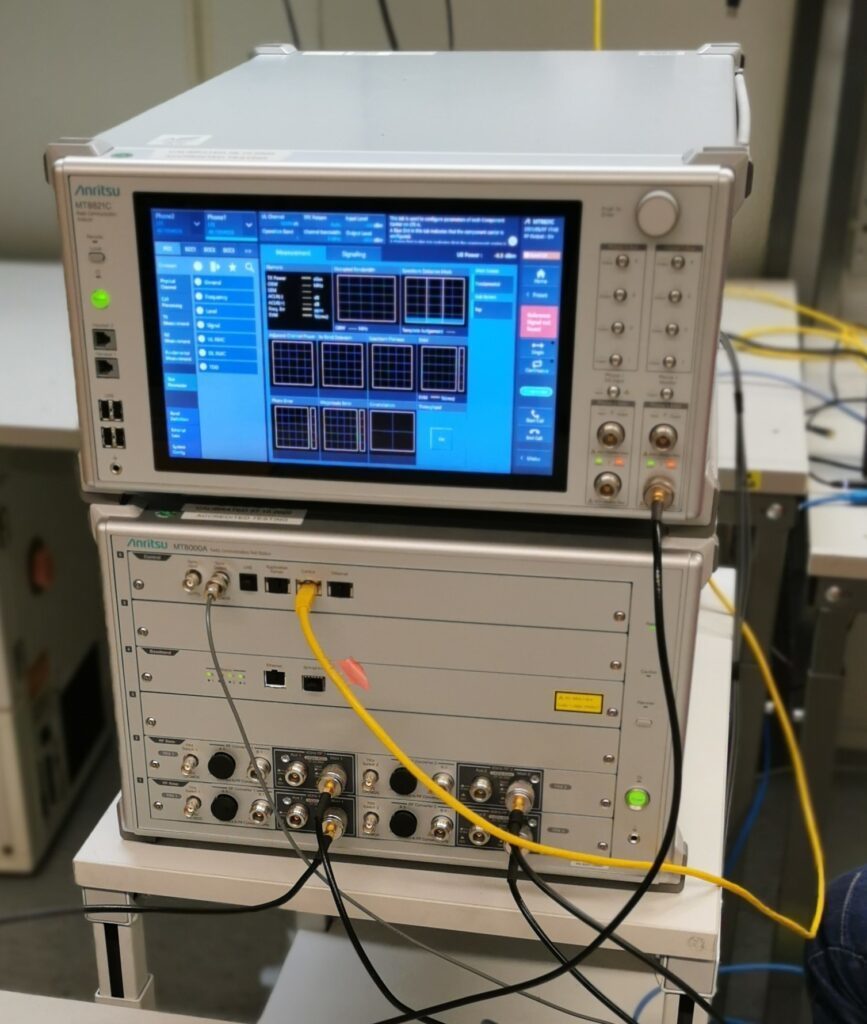
Before performing the OTA test the chamber needs to be prepared. The right testing instruments need to be selected and all the necessary cables need to be attached. At Verkotan we are using Anritsu’s testing instruments MT8820C, MT8821C and MT8000A, and Rohde & Schwartz’s testing instrument CMW500, depending on what kind of a radio is being under test.
Reference testing
One step to do before the actual test is reference testing. It means that when the chamber is ready for the actual test, some antenna which performance and measures are already known, is measured again in the chamber. The result will tell if everything is functioning as it should be: if the test results match the earlier results, everything is installed right, if they differ, something is not functioning right. Reference testing ensures our accurate high-quality test results. When the reference testing is done, the actual testing can begin.
Attachment of the device
Last thing to do is to place the DUT in a test chamber. Smartwatches are typically tested with test phantom hands, which are placed on top of the Rohacell or Styrofoam platform. These materials are used since Rohacell and Styrofoam consist of mostly air, so they do not interfere with the testing.
Sometimes some special user occasions need to be considered when attaching the device. For example, is the device used with some protective clothing, such as working uniforms. The test can be conducted with the needed clothing to correspond to the real-life user experience. With a smartwatch, there are some things that can affect the performance of it, for example a thick glove, sleeve or jacket.
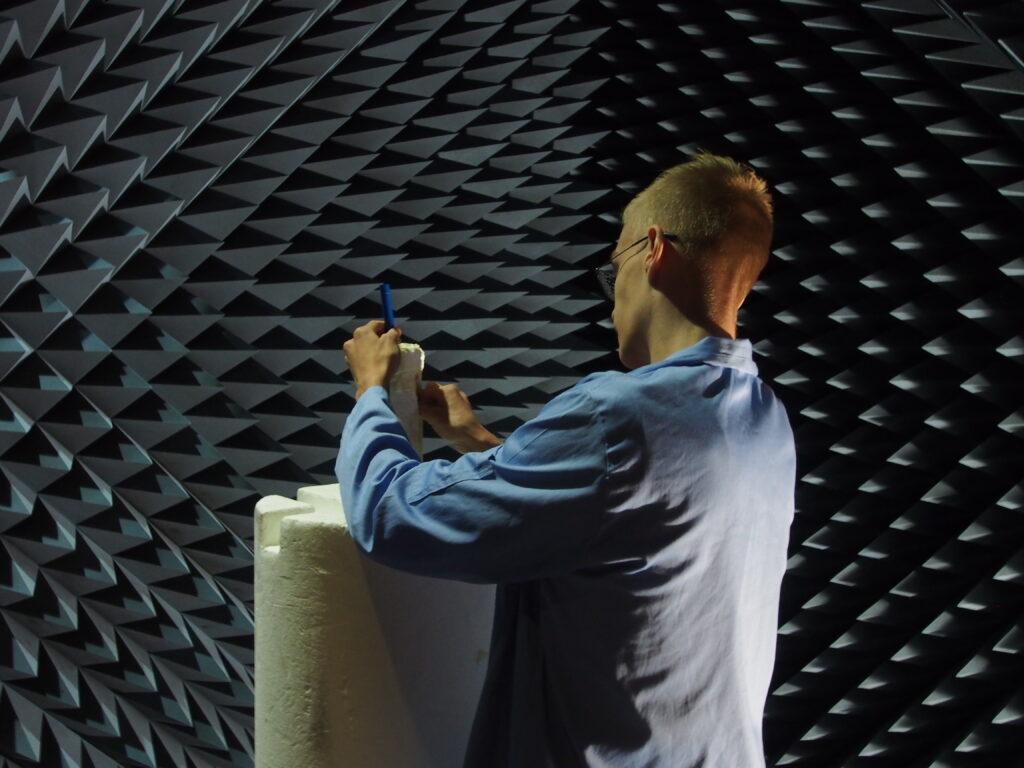
3. Test phase
When everything is set ready for the Over-the-Air, OTA testing, the next thing to do is to begin the testing. The purpose of the OTA testing method is that it simulates real life radio wave propagation conditions as realistically as possible. The tests are done in an anechoic chamber which are covered with absorber material to minimize the RF signal reflections. The absorber material consists of rubberized insulating foam with conductible metals and is usually shaped as a triangle. The benefit of the OTA test that is done in an anechoic chamber instead of in-field, is that in a controlled laboratory environment all the noises that might interfere the testing are eliminated.
Verkotan OTA tests
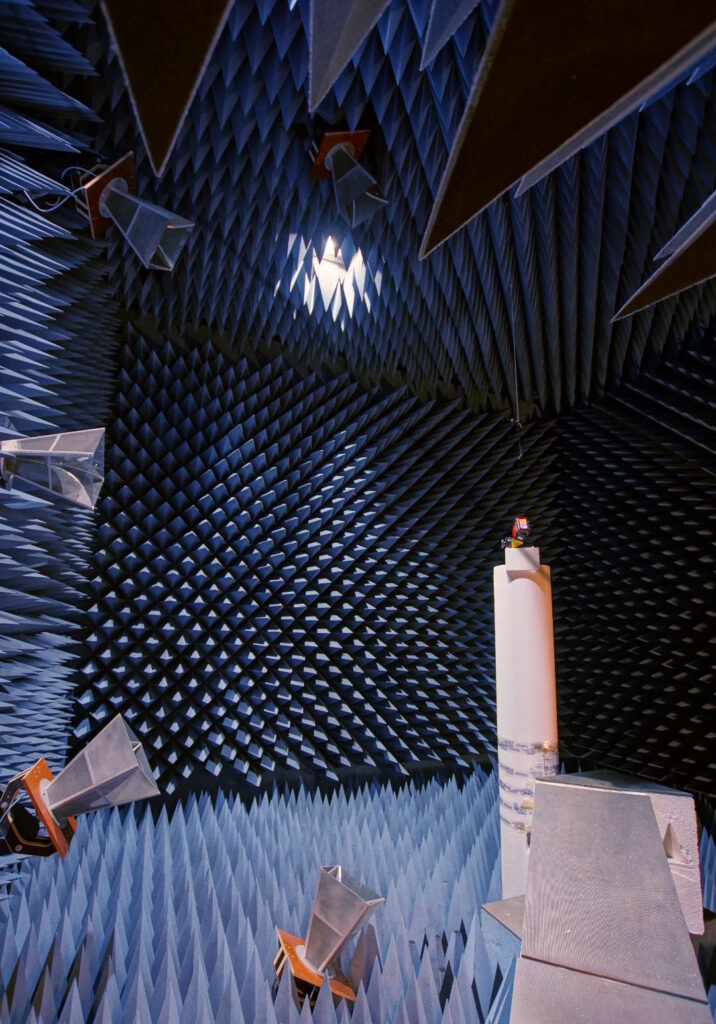
Verkotan test chambers have multiple measuring antennas, which enable extremely quick measurement times.
The testing itself means that a radio connection is created between the smartwatch and the test equipment. This is typically done with a software. At Verkotan, we have a software which helps us with the testing. The software measures the wireless connections quickly, accurately, and reliably. The software has been developed in house, and we have over 20 years of experience of the software development. Thus, we are able to tailor the software for different test cases easily and effortlessly.
Conducted testing
An alternative option for OTA testing is conducted testing. Conducted RF-testing is more traditional method and means that the device’s temporary antenna connectors, which are ports used for conformance testing, are connected to wired cables. The advantage of the conducted testing is that it can be done in a very early phase. This testing is typically done to very early-stage mobile device versions, for example to antenna elements without any mechanics around it. The downside of a conducted testing is that it does not measure the wireless performance of the antennas, which can be measured with OTA testing. It does not either consider the problems that the antennas might have in the finished product, when the product contains all its elements, such as batteries and all the other exterior mechanics.

4. Reporting
The last step of our Over-the-Air, OTA testing process is reporting. When the OTA testing is done, it is time to report the results. For reporting the results, we at Verkotan use AntView® tool. It is a tool that makes storing, visualizing, and analysing the antenna measurement results easier. One of the many advantages of AntView® is that it makes visualization of the data easy. AntView® enables fast antenna characteristics analysis, which makes it easy to compare multiple antenna measurement results, e.g. BASTA parameters, and present them in easily understandable formats with graphs, bars and colors. The test results are imported to a web browser and cloud service so that the access to the database information is effortless for our customers.
If you are interested, we are offering a free demo access to our AntView® software. The process how to get the demo access is very straight forward. Fill out the form to request access to the demo and in three business days we will send you the username and password for AntView®. After getting the access, you can start exploring the software!
By getting the demo access you are not obligated to anything. We do not require any information other than your name, e-mail, phone number and a company name.
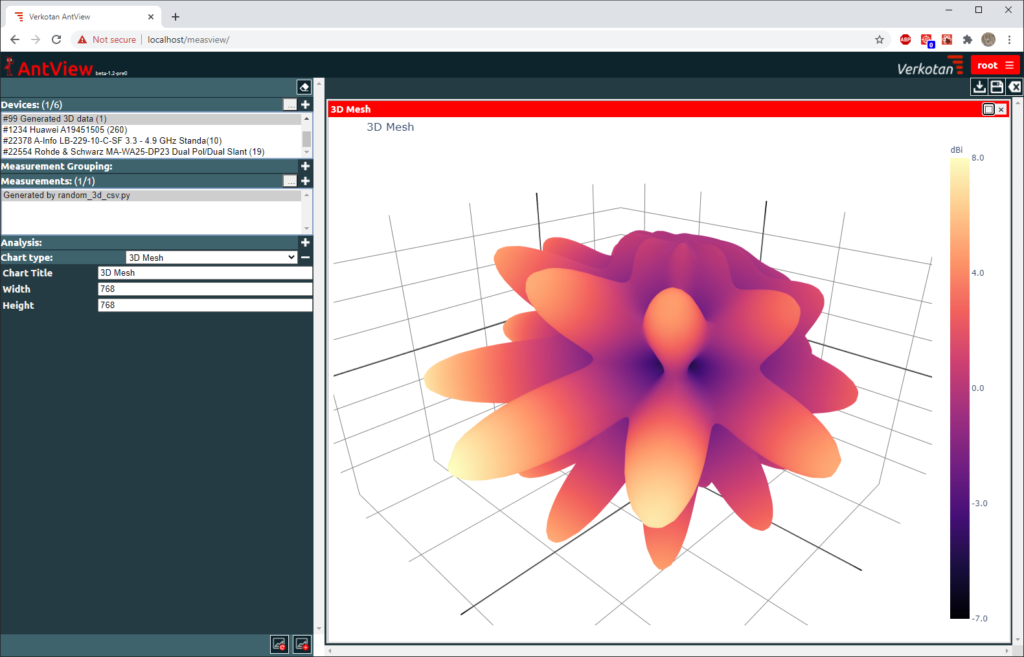
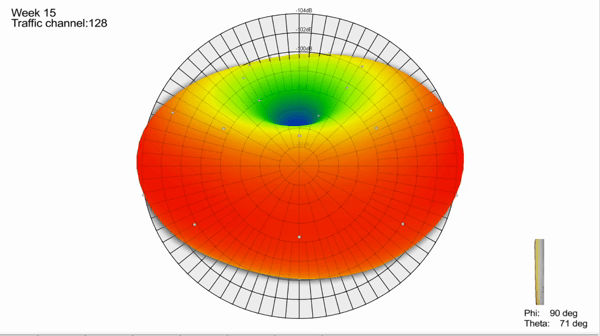
Verkotan is always happy to provide more detailed information and make a proposal, how we, at Verkotan can verify your devices wireless performance in the global environment.
If you have any questions or need assistance, contact us. We are happy to help you!
